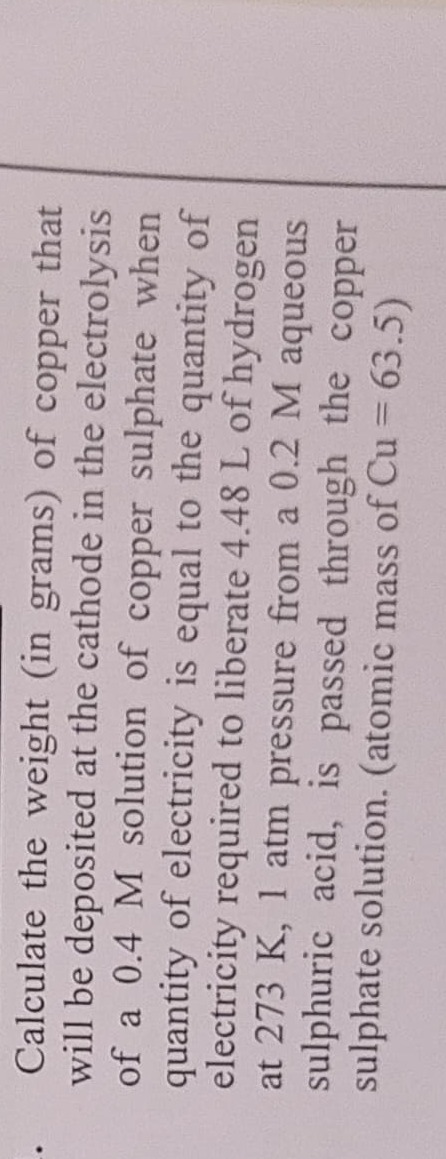Question
Question: Calculate the weight (in grams) of copper that will be deposited at the cathode in the electrolysis ...
Calculate the weight (in grams) of copper that will be deposited at the cathode in the electrolysis of a 0.4 M solution of copper sulphate when quantity of electricity is equal to the quantity of electricity required to liberate 4.48 L of hydrogen at 273 K, 1 atm pressure from a 0.2 M aqueous sulphuric acid, is passed through the copper sulphate solution. (atomic mass of Cu = 63.5)

12.7
Solution
To calculate the weight of copper deposited, we need to follow these steps:
Step 1: Calculate the moles of hydrogen gas liberated. At STP (273 K and 1 atm pressure), 1 mole of any gas occupies 22.4 L. Given volume of hydrogen (H₂) = 4.48 L Number of moles of H₂ = Molar volume at STPVolume of H₂ Number of moles of H₂ = 22.4 L/mol4.48 L Number of moles of H₂ = 0.2 mol
Step 2: Determine the quantity of electricity (in Faradays) required to liberate 0.2 mol of hydrogen. The reaction for the liberation of hydrogen at the cathode from aqueous sulphuric acid is: 2H+(aq)+2e−→H2(g) From the stoichiometry, 1 mole of H₂ gas requires 2 moles of electrons. Since 1 mole of electrons carries 1 Faraday (F) of charge (96500 C), 1 mole of H₂ requires 2 Faradays of electricity. Quantity of electricity required for 0.2 mol of H₂ = 0.2 mol H2×1 mol H22 F Quantity of electricity = 0.4 F
Step 3: Calculate the mass of copper deposited using the same quantity of electricity. The reaction for the deposition of copper at the cathode from copper sulphate solution is: Cu2+(aq)+2e−→Cu(s) From the stoichiometry, 1 mole of copper (Cu) requires 2 moles of electrons for deposition. The atomic mass of Cu is 63.5 g/mol. So, 63.5 g of Cu requires 2 Faradays of electricity for deposition.
We have 0.4 F of electricity passed through the copper sulphate solution. Using the relationship: Mass of substance deposited = Faraday’s constantEquivalent weight×Quantity of electricity (in Coulombs) Or, more simply using Faradays: Mass of Cu deposited = Electrons per mole of CuQuantity of electricity (in F)×Molar mass of Cu Mass of Cu deposited = 2 F/mol Cu0.4 F×63.5 g/mol Mass of Cu deposited = 0.2 mol Cu×63.5 g/mol Mass of Cu deposited = 12.7 g
Alternatively, using Faraday's second law of electrolysis: Equivalent weight of H2Mass of H2=Equivalent weight of CuMass of Cu Mass of H₂ = 0.2 mol×2 g/mol=0.4 g Equivalent weight of H₂ = n-factorMolar mass of H2=22 g/mol=1 g/eq Equivalent weight of Cu = n-factorMolar mass of Cu=263.5 g/mol=31.75 g/eq 1 g/eq0.4 g=31.75 g/eqMass of Cu Mass of Cu = 0.4×31.75 g Mass of Cu = 12.7 g
The concentrations of the solutions (0.4 M CuSO₄ and 0.2 M H₂SO₄) are not needed for this calculation, as long as the solutions are sufficiently concentrated to provide the necessary ions.
The final answer is 12.7.
Explanation of the solution:
- Calculate moles of H₂ from its volume at STP (4.48 L / 22.4 L/mol = 0.2 mol).
- Determine the Faradays of electricity required for H₂ liberation (0.2 mol H₂ × 2 F/mol H₂ = 0.4 F).
- Use this quantity of electricity to find the mass of Cu deposited (0.4 F / 2 F/mol Cu × 63.5 g/mol = 12.7 g).
Answer: 12.7 g
